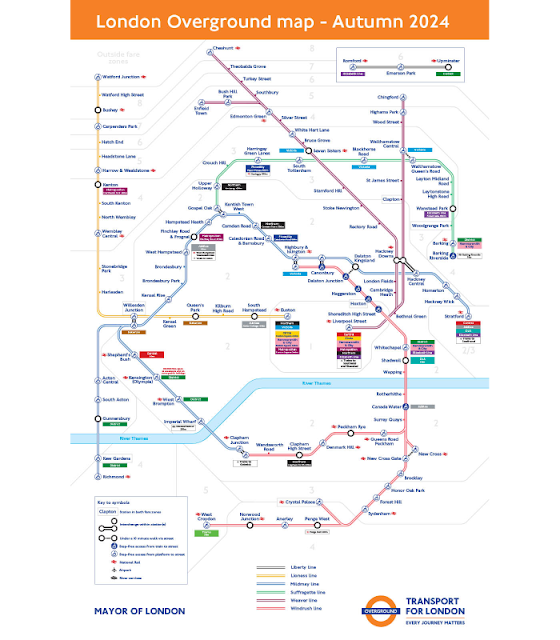"Names mean almost nothing." - Jean-Luc Picard
"Names mean almost everything." - Jack Crusher
 |
| Image Copyright TfL |
So, from Autumn 2024, the six London Overground lines are to be given distinct names and colours.
London Mayor, Sadiq Khan, has finally followed through with one of his 2021 Labour Mayoral manifesto pledges, which was to overhaul and rename the London Overground lines. The total cost of the project is around £6.3 million, which is an eye-watering amount of money, especially with current financial woes.
But, hey, it will make things clearer and easier... won't it?
After hearing this news, I thought it would be fun to look at the etymology of the London Underground line names, before looking at the new ones.
Bakerloo - A portmanteau of the 'Baker Street and Waterloo Railway'.
Central - Originally called the Central London line it was shortened to Central line in 1937.
Circle - Quite simply the line is a loop. Easy. Except, as of 2009, it no longer runs in a complete circle.
District - Originally built by the Metropolitan District Railway, it became known as the District line so as not to be confused with the Metropolitan Railway.
Elizabeth - Originally this line was to be called Crosstrail, but, no. Once again a more regal name was chosen, and so was named in honour of HM Queen Elizabeth II.
Hammersmith & City - Quite simply it runs from Hammersmith and through the City. Boring.
Jubilee - Originally proposed as the Fleet line, various financial issues, construction delays and changes to its route saw it called the Jubilee line, in honour of Queen Elizabeth II's silver jubilee in 1977. Nice, but the line didn't open until 1979 and wasn't completed until 1999.
Metropolitan - The world's first underground railway was built by the Metropolitan Railway Company. I think the clue is in the name.
Northern - The City & South London Railway built the first proper underground line, built by boring a tunnel, rather than the cut-and-cover method. The Charing Cross, Euston & Hampstead Railway became owned by the Underground Electric Railways Company of London. In 1914 the Underground Electric Railways Company of London bought the City & South London Railway and, by adding extensions, allowed the lines to run on the same line. None of this explains why the name Northern was chosen though.
Piccadilly - The Great Northern, Piccadilly & Brompton Railway ran from Finsbury Park under Piccadilly to Brompton. Quite simply, as the line reached the West End the name was shortened to simply Piccadilly.
Victoria - In 1955 plans were put forward for a new underground line between Victoria and Walthamstow. While planning the line various names were suggested. First there was the Walvic line (Walthamstow-Victoria) and the much better Viking line (Victoria-King's Cross). However, those that know best decided to be as boring as possible and call it the Victoria line. I much prefer Viking line.
Waterloo & City - The London and South Western Railway had their terminus at Waterloo Bridge, from where they ran trains to Southampton and back. However, for those people who needed to cross the river, this wasn't good enough. Thankfully, a new company named the Waterloo & City Railway Company obtained permission to build a new line from Waterloo Bridge to a new City station. The line was immediately called the Waterloo and City, although City station would be renamed Bank, the line kept its name.
So now we come to the six lines that make up the London Overground.
Transport for London, the mayor's office and the company DNCO, who all worked together on the project, have not released a list of all the names that were suggested.
What was clear, though, is that the colours had to be distinct enough so as not to clash with already established lines, while the names had to evoke history and stand the test of time. Plus, the names had to be tested through a tannoy system, to make sure that they were identifiable.
However, I am glad that things like 'East London line' and 'North London line' were dropped.
Liberty - Romford - Upminster. It is named "to reference the historical independence of the people of the borough of Havering", through which it runs, as well as celebrating "a defining feature of London".
Lioness - Watford Junction - Euston. Running through Wembley, the name is to honour the achievements of the England women's football team.
Mildmay - Richmond - Clapham - Stratford. Named after the small charitable hospital in Shoreditch, which played an important role during the HIV/Aids crisis in the 1980s.
Suffragette - Gospel Oak - Barking Riverside. Named to celebrate how London's East End working-class community fought for women's rights, the line also runs to Barking, home of the longest-surviving suffragette, Annie Huggett, who died aged 103.
Weaver - Liverpool Street - Chingford - Cheshunt - Enfield Town. With stops including Liverpool Street, Spitalfields, Bethnal Green and Hackney, the route travels through several areas of London known for their importance in the textile trade.
Windrush - Highbury & Islington - Clapham Junction - New Cross - Crystal Palace - West Croydon. Running through several areas with strong ties to Caribbean communities, including Dalston Junction, Peckham Rye and West Croydon, it has been named to honour the Windrush community.
For more information on London's Transport Network, click the link below.
London's Transport Network Information
No comments:
Post a Comment